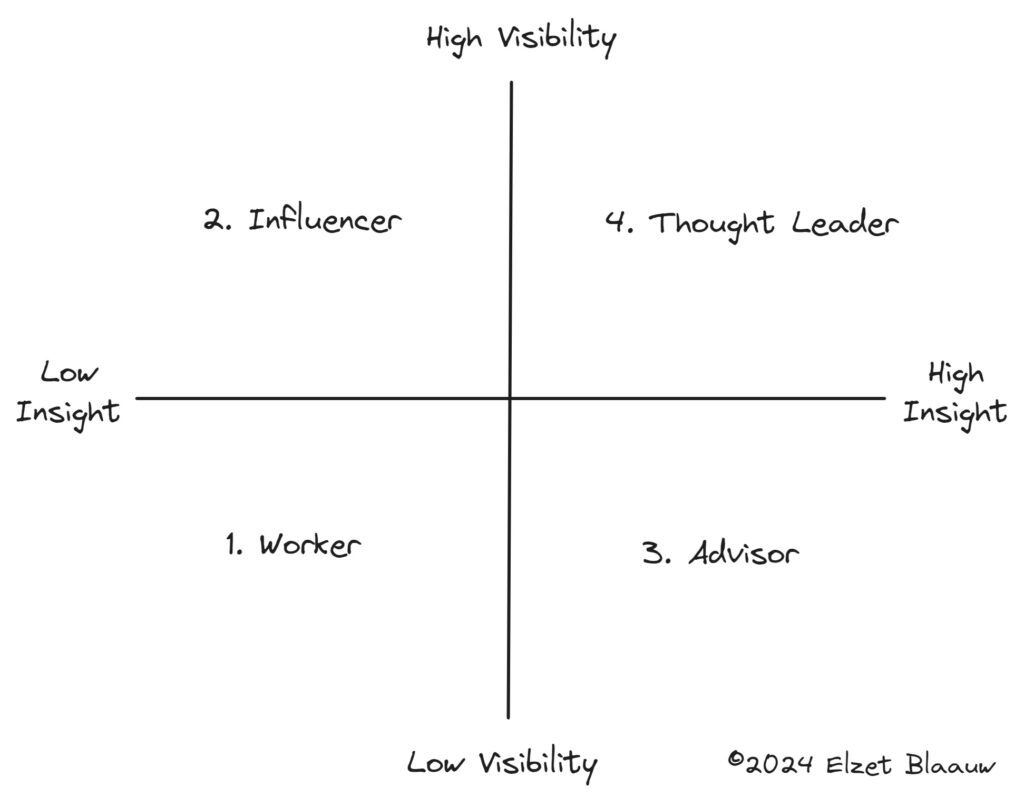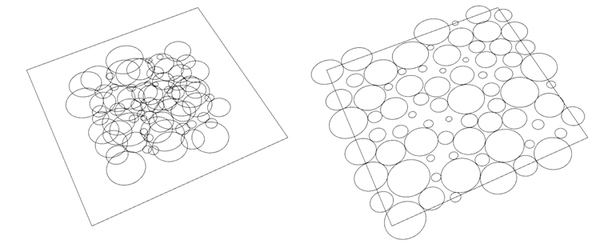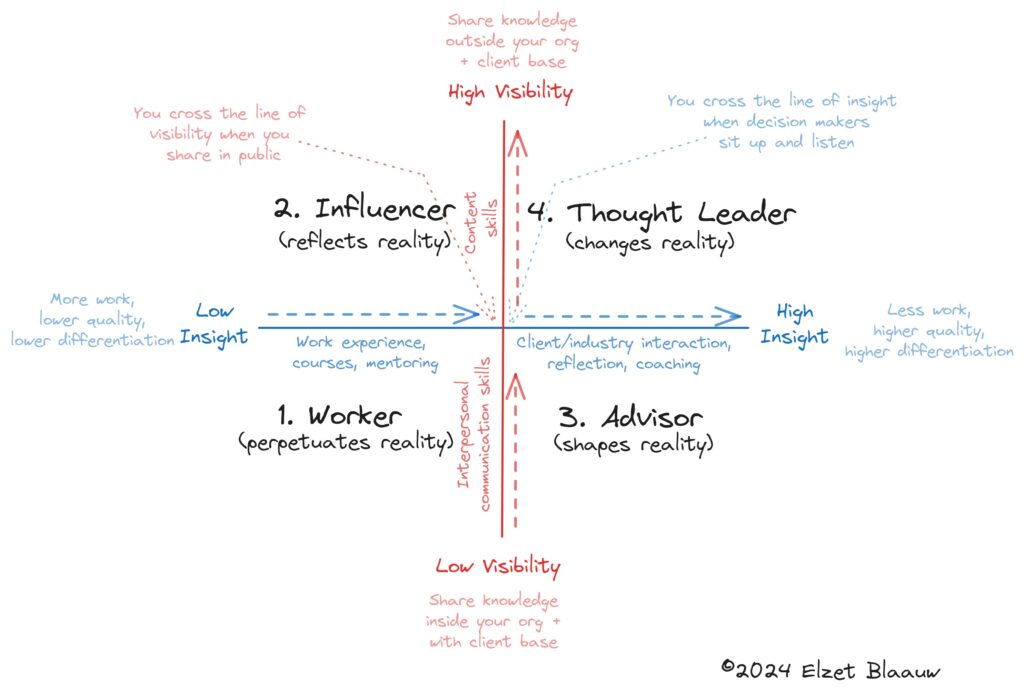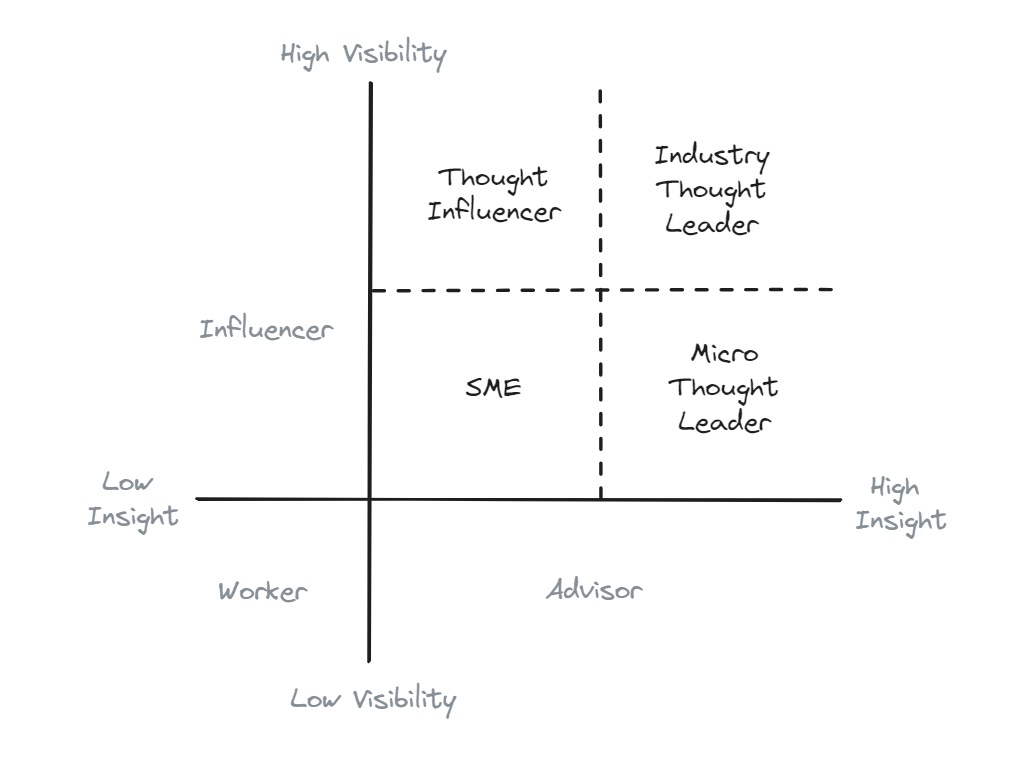An extended conversation with Elzet Blaauw on thought leadership and some very insightful diagrams she has developed to map the fundamentals.
A Conversation with Elzet Blaauw on Thought Leadership
Elzet helps authentic experts get clear on their purpose and how to explain the unique value they have to offer, how that value fits into the market, and how to communicate their purpose and positioning consistently. Learn more about her at https://www.linkedin.com/in/elzet-kirsten-blaauw/
What follows is an edited transcript of our conversation punctuated by three of Elzet’s diagrams and one from Valdis Krebs.
Edited Transcript
Sean Murphy: Today, I’m talking with Elzet Blaauw about thought leadership and its various aspects. Thought leadership has become a hot topic, and we want to explore different perspectives. In particular, we want to distinguish what people do to help their audience versus gaining visibility or attempting to please the algorithmic curation used in some systems. Elzet, please introduce yourself.
Elzet Blaauw: Thanks, Sean. I have worked in thought leadership my whole life without knowing it.
When I came across this term a few years ago, I thought, “Yes! This is it! I finally have a word for it.” But I then found that people have many different interpretations of what this concept actually means. Some disciplines, like marketing, have co-opted thought leadership in terms of what it means for them. And thought leadership is tricky because it combines two abstract words: thinking and leading. That’s what led me to thinking about what it is, how it’s used, and how I see it.
So, how do you define thought leadership, Sean?
Sean Murphy: I have also given this some thought and define thought leadership as a briefing or an article that helps the audience discern important events and trends at work in the present, predict their likely effects, and offer perspective and actionable advice in time to have an impact. I am guided by Marcelo Rinesi’s observation: “The future is an abstraction, all change is happening now.“ You can only take action in the present.
Elzet Blaauw: To be honest, I don’t have a neat definition like that. But I see thought leadership as a practice more than a deliverable, outcome, or artifact. It includes the talk or the article. But it’s also the process of thinking that goes into producing that artifact. What do you think? How do you work to produce that kind of thinking? And then part of it is how do you share your ideas? And what do you share?
I think you and I are looking at the same bush from two different angles. We aim to understand: how do you help people make sense of what’s happening now? What’s coming, and what actions should they take?
It’s helping people solve their problems. Helping them think about what their problem is and how to move towards a solution. That why there’s much overlap between thought leadership and problem-solving or providing a service; thought leadership is just more of the theoretical or mental part of it.
Expertise is “Have Done, Can Do” Within a Circle of Competence
Sean Murphy: I look at expertise as “have done, can do.” It’s proof of skill or knowledge substantiated by past performance. An expert has a track record of good decisions, sound judgments, and actual accomplishments they can point to. They have what Warren Buffett calls a “circle of competence” where they can achieve above-average results. They have intuition born of experience that allows them to offer accurate insights based on a small amount of information or make high-quality decisions rapidly. Outside of that circle, they are like everyone else or, in some cases, worse than most. People are not “general experts;” they have specific expertise. Does that match your experience?
Elzet Blaauw: Yes, I find the “circle of competence” a very useful mental model. You need to know what you’re good at and operate in that space. It ties in with what I call your thought leadership positioning: How do you position yourself? Where do you want to stand?
If you think about physical space, am I standing in this circle? Or am I standing over there in that circle? How you perceive me will be very different.
And it’s not all these discrete circles. You can stack your competence circles on top of each other to make your positioning more unique.
Sean Murphy: There’s a great chart by Valdis Krebs that shows how both stack in different ways. Krebs would argue that a critical aspect of your know-how is tacit, gained from teams or groups you join.
I think he is correct, but it’s not what we learn when we are young. We study subjects in school that are divided up into neat boxes. We are given the lesson and then the test. And the tests respect the same boxes: you don’t get a question on a history test that asks you to solve a math problem.
But life frequently gives the test first, and says you must figure out what you need to learn to solve it. Depending upon what you are trying to solve–or at least manage–you may need to blend information from several different disciplines. Many problems are messes that don’t come in neat boxes. To manage them, you need perspectives from multiple disciplines
I think there is also value in looking at the present situation, what happened in the past that may have influenced it, and where it may evolve in the future. “What’s happening now?” is always an important question, but so is determining what past events may be influences or root causes. When we can “agree on the facts,” we have a shared understanding of what happened in the past. Making sense of the present involves extracting critical information out of what can be a jumbled confusion. Robert Lucky observed, “I have gradually come to appreciate that the really important predictions are about the present. What is happening right now, and what is its significance?”
Then there is prediction: how will this carry forward into the future? That’s important, but it’s probably less important than reaching an agreement on the facts and a shared understanding of what’s happening that’s significant right now.
Elzet Blaauw: Do you see people stacking those three levels of analysis—past, present, and future—on top of each other? So you first make sense of the past, then the present, then the future? Or can they be combined in different ways?
Sean Murphy: I usually start by trying to make sense of what’s happening now. Then, I look back to see if I can spot trends that can help me map a range of trajectories for how the current situation may evolve. Sometimes, I realize that I am facing a discontinuity where much of the knowledge I have accumulated about a particular area may be obsolete. Significant technology breakthroughs can change the rules. Churchill’s observation that “The longer you can look back, the farther you can look forward” holds about 90% of the time. I think these frames stack most of the time, but not all changes are continuous.
Start by Making Sense of What’s Happening Now
Elzet Blaauw: I like that. What I see most often is that people start with what’s happening now, especially if they come from business or practice instead of academia. They are accustomed to learning by doing, and learning more as they continue as practitioners. Next, they start looking back at what has come and thinking about what’s coming or may happen. So they start with here and now and then explore forward and backward.
I agree that someone who has been a practitioner for 40 years can be blindsided if outside factors trigger a substantial change. Someone who has not been a practitioner for a long time may find it easier to incorporate the change into their perspective. A newcomer may see the change immediately because they are not trying to navigate with an obsolete map.
But someone who’s been doing something for decades and is still curious about their discipline brings depth and breadth of insight worth respecting. For instance, you introduced me to the concept of a “community of practice” in relationship to thought leadership. None of my peers have mentioned it as relevant; they mostly look at thought leadership as a marketing activity, which is how I learned about it.
Let’s go back to the circle of competence model. I use it in my thinking, and when I work with clients, I explain how you can have more than one area of expertise. Some may be stacked, while others can be adjacent but still support a unique mix of competencies. I encourage them to combine multiple circles of competence and build a niche to differentiate their practice and elevate their thought leadership. Suddenly, you’re not an expert in just one area but an expert in the intersection of two or three different disciplines. This combination of different competencies and practical experiences allows you to solve problems that very few others can.
Insight vs. Visibility
The other thing about thought leadership that I believe is important to note is that it isn’t only about visibility. I developed the two-by-two diagram below to explain what thought leadership is and isn’t. It simplifies things, and it leaves out some nuance. When I created it, it was my way to make sense of what I was seeing, how I was hearing people talking about thought leadership, and what I felt was missing.

I want to draw a significant distinction between the influencers in quadrant two and the thought leaders in quadrant four. They both have high visibility, but a thought leader also offers high insight. Honestly, you can replace insight with expertise if you like: I went back and forth and settled on insight because I had not heard your nice definition of expertise at the time.
Fundamentally, I saw many people equating high visibility with thought leadership, and I felt that was a problem. I wanted to be clear that you can have high visibility and not have high insight. Or, what may be worse, someone who has high insight can try to show up as an influencer and miss their opportunity at thought leadership altogether.
Sean Murphy: What you call an influencer may sometimes be more of a celebrity, someone famous expressing an opinion they are not qualified to offer. I think “common wisdom” falls into this category; it’s visible and correct most of the time, but not always.
Elzet Blaauw: Absolutely.
As I worked on this diagram, I realized that most people start their careers in the bottom left-hand corner of quadrant one, where they have no visibility and no insight. They do things but may not always understand the bigger context. As they grow in their careers, they get more insight, and for most people, that means they move into quadrant three.
Sean Murphy: One thing I see about quadrants one and three is that when you get stuck in any team or organization, there are people you go to for advice. Over time, you learn who has real insight—or at least more than you—and you learn from them. I think low visibility means they may only be known within the team or within the organization. But either way quadrant three people are respected.
Zooming In: Distinguishing Between Influence and Thought Leadership
Elzet Blaauw: Yes, absolutely. Here is a busier version of the basic map with more annotations. As you gain more respect and influence, you move to the right. People in quadrant three are those internal gems that only colleagues and the clients they interact with know about.
If you’re in quadrant three, you’ll often find yourself talking to customers, prospects, partners, and others outside your organization more, especially in expertise-based businesses. That moves you up towards the horizontal line. For me, the midpoint of the visibility axis, the demarcation between low and high visibility, is whether people outside the organization and its clients know about you and your work.
Sean Murphy: I love this diagram.
Elzet Blaauw: Okay, so we will use the busy one for now then.
I also want to clarify that I’m not passing judgment on what is better or worse here. I’m not ranking or rating these roles. Some people saw this and said, You’re hating on the influencers. But that was not my intention. Influencers reflect reality, and they can build successful careers and businesses on that ability. Many people also listen to what they say compared to those who have higher expertise. So I’m not saying it’s bad. It’s just what it is.
If you’re thinking about increasing your visibility, you want to ask yourself whether you’re simply perpetuating reality (quadrant one) at the moment. In that case, you want to move up to quadrant two where you’ll reflect reality, and many people will resonate with what you say.
But if you’re in quadrant three, where you’re already advising clients on why things are the way they are and where things may be heading, you don’t want to move back left to the influencer quadrant. You want to move up to thought leadership.
For instance, if you are a business owner or want to start your own company, you must sell your ideas and insights. Thought leadership becomes relevant because you must influence how others think on a larger scale—you need to increase your visibility. But it’s visibility based on your insights, not posting selfies or sharing jokes. I believe we shouldn’t confuse thought leaders with influencers because they follow different tactics.
It could also help to think about these quadrants as lenses. It’s a perception. Am I perceived as an advisor, a thought leader, or an influencer? It’s about how people perceive you.
Sean Murphy: There is a straightforward test for people who say, “I want to become a leader or a trusted advisor.” Will others follow your lead or take your advice? Do people come to you for guidance and advice? In my experience, people follow you because they can understand what you are suggesting, it agrees with their goals and values, and the advice you’ve given them in the past has proven solid.
Four Kinds of Thought Leadership
Elzet Blaauw: Exactly. And it goes back to the beginning of our conversation: you want to operate in your areas of expertise or circles of competence and be respected by others for that competence.
And it also gets more granular than that, which led me to divide the fourth quadrant, thought leaders, into four sub-quadrants.
As an aside, you can replace “micro thought leader” with “niche thought leader”, if that phrase resonates better for you.
Many people equate thought leadership with the top right corner, so 4.4, or what I called industry thought leaders. So these are the people who have best-selling business books. They’re well known: everyone knows who XYZ is and so on.
On LinkedIn, for instance, you have the people who post several times a day and have high visibility, and they do also have insight. But they spend time crafting their content because they want to appeal to lots of people.
They are in the top two quadrants. Their game has become content. Their product is thought leadership. They’re not using thought leadership as the gateway drug to their product. For them, thought leadership is the product. It’s what they do all day. They have to because getting such high visibility requires that you please the algorithm with lots of content.
Again, that is fine. But what about someone who is primarily doing something else, like running a business or growing a business? It is probably better to spend your time showing up in the lower two thought leadership quadrant as a subject matter expert, or SME, or in the micro thought leadership quadrant. If you’re running an expertise-based business, micro thought leadership is especially valuable because you want to be seen as a person with specific expertise that you use to solve a particular set of problems people will pay to see resolved.
So the aim of the game is not to get to the top right corner. The aim of the game is to land somewhere on this map that will be most beneficial for you, your business and your audience.
Personally, I’m very interested in micro thought leadership. The level of complexity in the world and in business is increasing so much, and we need more people who can own one specific problem or perhaps one problem pocket and dive into it and find the best solutions for it. I believe we need many more of these people, and I believe this is where you can get immense competitive advantage compared to even large, well-known organizations that are trying to do everything and be everything to everyone.
Thought Leaders Must Stay Engaged to Renew Expertise
Sean Murphy: People follow a “guru” because they believe the guru has achieved enlightenment. But for me, enlightenment–more accurately, expertise–is a moving target. Mastery in a community of practice continues to evolve. People remain experts because they continue to work in the field and solve new problems with methods that enable more effective practice. People who spend all their time writing articles and giving talks are not renewing and extending their expertise.
Elzet Blaauw: Wow, my brain just exploded a little bit when you said that. I’m imagining these quadrants slowly moving to the left because things are constantly changing. If you are viewed as an industry thought leader but don’t keep practicing and learning, you will start moving to the left. Your insight will decrease over time. You may stay highly visible because you are still producing content, but your level of insight is decreasing. So you’ll move into quadrant three.
That’s the advantage of micro thought leadership. You’re not as visible, but it’s easier to stay relevant and maintain a high level of insight and expertise.
Sean Murphy: I agree with the benefits you outlined for micro-thought leadership.
One pattern I’ve noticed in several industries I have worked in is that most firms rely on a few people for explanations. I think it’s somewhat random, but being early in a new technology cycle they understand, having strong written and verbal communication skills, and the ability to listen all seem to help. They are in many conversations where they learn a lot if they listen. Even if they cannot offer deep insights, they can share what they have heard subject to appropriate respect for confidentiality. They act as a condensation point for what’s happening now and pass along common wisdom. They may not be practitioners but can learn about problems and opportunities.
Elzet Blaauw: Yes, those would be your quadrant threes.
Sean Murphy: Also, industry players often employ a range of technologies and methods: some are old, limited, very reliable, and well-understood; most are current, reasonably reliable, and widely deployed; a few are emerging, unreliable, poorly understood, but potentially very powerful. When these respected “explainers” talk to people exploring emerging approaches, they can get a peek at the future. This means that their predictions or forecasts flow less from practice and more from observing people who seem like they’re pioneering a better way.
What you call a thought influencer may sometimes be more of an information broker or an information-sharing nodes.
Summing Up
Elzet Blaauw: I like this perspective of thought influencers as information sharing node.
If you’re using the language of the community of practice paradigm–layman-novice-journeyman-master levels of skill or expertise–thought influencers can be journeymen. They’re somewhat knowledgeable and can elevate the insights and ideas of others and make them more widely available. Because masters don’t have a monopoly on new ideas–newcomers and novices can also offer insights from their experiences or their “beginner’s mind.” So, the thought influencers’ efforts to share and elevate information enrich the conversations and practices in the broader community.
Thought influencers can also be useful for masters who may practice a different discipline or come from a different background than the beneficiaries of their expertise. Thought influencers can help translate their message to their target audience.
For instance, you might have expertise as a data engineer. But you’re not speaking to other data engineers; you’re selling your expertise to the CEO of a retail company. He doesn’t know much about data engineering. He just knows he wants business insights. He needs to make decisions, and he needs to have this information readily available.
If you think about it like that, these quadrants are a lens people use to examine your thought leadership. You must ask yourself who you’re trying to reach and how they perceive your work.
Most of the time, you’ll discover that you might have more of an advantage than you think. Because if you’re the data engineer and comparing yourself to other data engineers, you might just scrape into the SME quadrant. However, the retail CEO won’t be able to differentiate between you and someone who is a master (in community of practice language) in data engineering who is coming up with new terms to further the industry. In the CEO’s eyes, you’re the expert if you understand his problem and show how your data engineering skills can solve his problems.
This goes back to the question that each person who wants to practice thought leadership must answer: why are you doing this? What are your aims? Who are you trying to reach? You need to decide that and then act accordingly.
Sean Murphy: I think that’s a well articulated summary to pause on.
We have a part two of this conversation coming in a separate blog post in a few days.
Related Blog Posts
- A Briefing on Thought Leadership
- Thought Leadership: Rotary Club Four Way Test
- Getting Oriented to a Subculture or Community of Practice
- Real Innovation Requires a Community of Practice Fostering a Cascade of Inventions
- Entrepreneurs Need a Community of Practice Not a Movement
- Circle the Chairs
- July/August 2016 Newsletter: Thought Leadership
- Content Creation for Thought Leadership and Lead Generation
- Mary Sorber: SKMurphy Offers Practical Advice on Thought Leadership
Related Articles
- “Map of Conscious Thought Applied to Thought Leadership” by Elzet Blaauw
- “Love Your Competitors” by Elzet Blaauw
- “How to Be a Leader In Your Field” by Phil Agre
Image Credit: “overlapping Circles” (c) Valdis Krebs, used with permission. Three quadrant diagrams offering models of Thought Leadership (c) Elzet Blaauw, used with permission.



